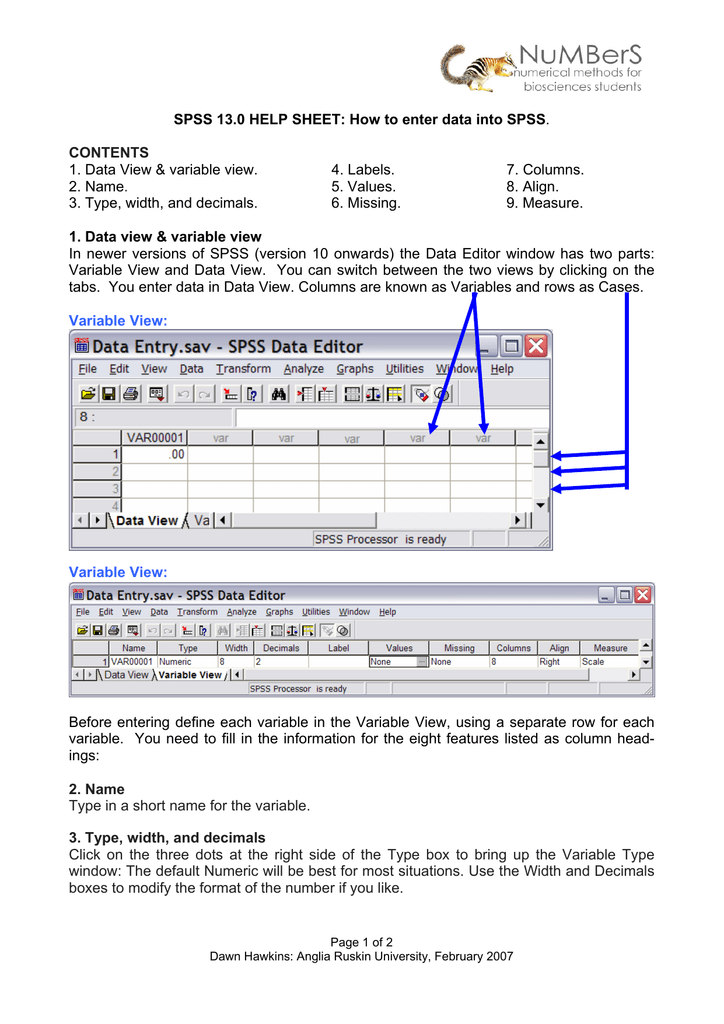
- HOW TO ENTER DATA IN SPSS HOW TO
- HOW TO ENTER DATA IN SPSS SOFTWARE
nesting) may be stored in a “relational” database, but those are harder to learn than spreadsheet software. Data that contains such relations (a.k.a. There may be higher levels of relations, such as students within classrooms, then classrooms within schools. They may be people who all live in the same home, or samples that all came from the same site.

Some data sets contain observations that are related in some way. However, if you cut & paste if from elsewhere, remove carriage returns first as they will cause it to jump to a new cell.
For text analysis, you can enter up to 32K of text, or about 8 pages, in a single cell. Note that dates are recorded differently across countries, so make sure you are using a format that matches your locale. You can enter dates with slashes () and times with colons (12:15 AM). HOW TO ENTER DATA IN SPSS SOFTWARE
Although SPSS and SAS use a period to represent a missing value, if you actually type a period in Excel, some software (like R) will read the column as character data so you will not be able to, for example, calculate the mean of a column without taking action to address the situation.
 For missing values, leave the cell blank. If the data represent gender, it’s common to use 0 for female, 1 for male. If the data are logical, use 0 for false, and 1 for true. If your group has only two levels, coding them 0 and 1 makes some analyses (e.g. Currency signs ($, €, etc.) can cause trouble in some programs. Avoid the use of special characters in numeric columns. For example to enter political party, you might enter 1 instead of Democrat, 2 instead of Republican and 3 instead of Other. Many statistics packages don’t work well with alphabetic characters representing categorical values. If you have multiple groups, put them in the same spreadsheet along with a variable that indicates group membership (see Gender example below). Position the ID variable in the left-most column for easy reference. You may need to sort the data later, after which the row number in Excel would then apply to a different subject or sampling unit, making it hard to find. Always include an ID variable on your original data collection form and in the spreadsheet to help you find the case again if you need to correct errors. No blank rows should appear in the data. No other text rows such as titles should be in the spreadsheet. Variable names should not contain spaces, but may use the underscore character. Those short names can be used by any software. When in doubt, use variable names that are no longer than 8 characters, beginning with a letter. If you know for sure what software you will use, follow its rules for how many characters names can contain. Consider the length of your variable names. Enter variable names in the first row of the spreadsheet.
For missing values, leave the cell blank. If the data represent gender, it’s common to use 0 for female, 1 for male. If the data are logical, use 0 for false, and 1 for true. If your group has only two levels, coding them 0 and 1 makes some analyses (e.g. Currency signs ($, €, etc.) can cause trouble in some programs. Avoid the use of special characters in numeric columns. For example to enter political party, you might enter 1 instead of Democrat, 2 instead of Republican and 3 instead of Other. Many statistics packages don’t work well with alphabetic characters representing categorical values. If you have multiple groups, put them in the same spreadsheet along with a variable that indicates group membership (see Gender example below). Position the ID variable in the left-most column for easy reference. You may need to sort the data later, after which the row number in Excel would then apply to a different subject or sampling unit, making it hard to find. Always include an ID variable on your original data collection form and in the spreadsheet to help you find the case again if you need to correct errors. No blank rows should appear in the data. No other text rows such as titles should be in the spreadsheet. Variable names should not contain spaces, but may use the underscore character. Those short names can be used by any software. When in doubt, use variable names that are no longer than 8 characters, beginning with a letter. If you know for sure what software you will use, follow its rules for how many characters names can contain. Consider the length of your variable names. Enter variable names in the first row of the spreadsheet.  All your data should be in a single spreadsheet of a single file (for an exception to this rule, see Relational Data Sets below.). Most data sets are easy to enter using the following rules. For a comprehensive list of these limitations, see and.
All your data should be in a single spreadsheet of a single file (for an exception to this rule, see Relational Data Sets below.). Most data sets are easy to enter using the following rules. For a comprehensive list of these limitations, see and. HOW TO ENTER DATA IN SPSS HOW TO
This article shows you how to enter data so that you can easily open in statistics packages such as R, SAS, SPSS, or jamovi (code or GUI steps below). Excel has some statistical analysis capabilities, but they often provide incorrect answers.







 0 kommentar(er)
0 kommentar(er)
